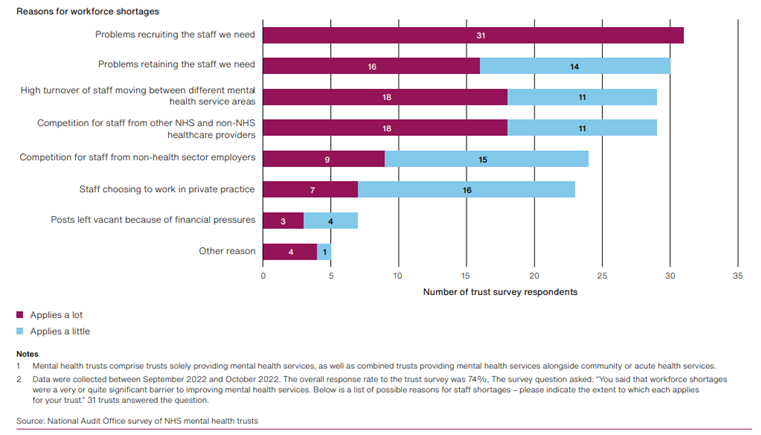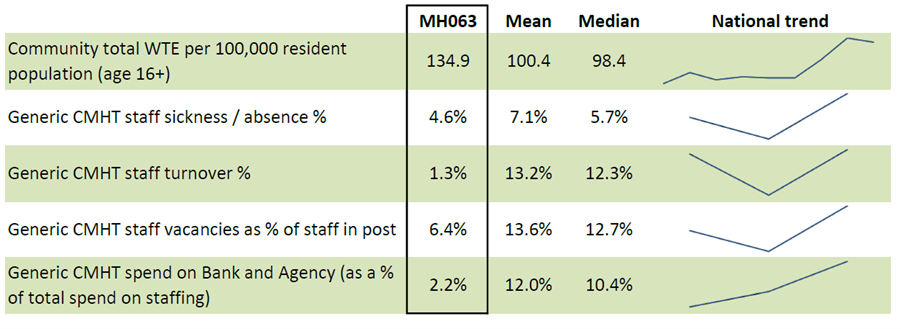Workforce
Partners from across the health and social care system must come together to plan and develop a workforce which can meet the needs of our local population (NHS Employers, 2022a).
NHS workforce
There is national acknowledgement that staff shortages remain the main constraint to improving and expanding mental health services. From 2016/17 to 2021/22, the NHS mental health workforce increased by 22%. Over the same time, referrals increased by 44%, meaning that the increase in staff was outpaced by the rise in demand for services (House of Commons Committee of Public Accounts, 2023).
- The Health and Social Care Committee’s Expert panel reported in 2021 that ‘lack of appropriate growth in the mental health workforce has led to negative impacts on both staff and services users’, with staff saying that unmanageable workloads meant that they were more likely to become exhausted or demoralised, or experience burnout (Health and Social Care Committee’s Expert Panel, 2021). These challenges were reiterated in the 2020 State of Care report (Care Quality Commission, 2023).
- The NHS Long Term Workforce Plan, published in 2023, predicts that demand for mental health services will grow faster than for other NHS services and confirms the particular challenge of expanding the mental health workforce.
- The National Audit Office surveyed mental health trusts in 2022 and found that the top reasons for workforce shortages are problems with staff recruitment and retention, high staff turnover and competition for staff from other healthcare providers.
Figure 25: NHS mental health trust survey respondents’ views on reasons for workforce shortages. Image source: Progress in improving mental health services in England
In the East of England, in the first quarter of 2023/24 there was a (NHS Digital, 2023b):
- 10.6% vacancy rate in all mental health posts
- 19.4% vacancy rate in mental health nursing posts
- 10.0% vacancy rate in medical mental health posts
- Note that this data does not capture how vacancy rates are filled by temporary staff. Full caveats for this data source are available here.
Local strategy
Workforce is one of the 4 priorities of the 2022 – 2025 Trust Strategy in Cambridgeshire and Peterborough NHS Foundation Trust. This strategy aims to achieve:
- Happy, healthy and appreciated staff provide better care for patients and carers.
- Staff will feel valued, have career opportunities, offered new ways of working and develop new skills to achieve their full potential.
- Staff will have access to a variety of resources to support their health and wellbeing.
The goals for 2025 are to:
- Reduce turnover to <10% and vacancy rates to be <7.5%.
- Achieve 75% of staff recommending the Trust.
- Increase nursing and AHP apprenticeships to achieve the national public sector apprenticeship target (2.3% of workforce) and exceed it by a further 1.75%.
- Increase the diversity of our senior workforce aligned to race disparity ratio measures.
Local picture
The average percentage staff sickness rate for CPFT was 4.74% in 2022/23, which was above the set target of 4.35%. The 12-month average turnover in 2022/23 was 15.75%, which is also above the Trust target of 10.50%.
National benchmarking reports from 2022/23 show that the community mental health workforce in Cambridgeshire and Peterborough NHS Foundation Trust (CPFT) was better than regional and national comparators, with low vacancy rates and relatively high staffing levels; and low absence rates, turnover and spend on banking staff.
Figure 27: Community Mental Health Team (CMHT) staffing levels in Cambridgeshire and Peterborough Foundation Trust (CPFT), 2022/23. Image source: (Benchmarking Network, 2023)
However, the vacancy rates in adult acute care (inpatient mental health wards) is substantially higher in Cambridgeshire and Peterborough compared to other areas. National benchmarking data shows that the local vacancy is 29%, compared to a national average of 18%.
- This places Cambridgeshire and Peterborough ICS within the highest quartile of adult acute vacancies in 2022/23, compared to other areas (Benchmarking Network, 2023).
- The effect of these staffing shortages led to the closure of an inpatient ward in May 2022. This had knock-on impacts across the system and contributed to increased use of out of area placements and problems with flow across the pathways.
Wider mental health workforce
The introduction of Integrated Care Systems (ICSs) provides an opportunity to embed integrated workforce planning (NHS Employers, 2022b).
Mental health support for non-specialised professionals
There has been growth in the number and types of way that mental health professionals support professionals in other sectors, who are not trained in mental health. The model of clinical supervision has been proposed as one method to support worker wellbeing, lessen compassion fatigue and create space for workers to think creatively, manage risk and develop trauma-informed and reflective practice.
- This approach has been used in particular to provide support to non-mental health professionals working with people with severe multiple disadvantage including repeat street homelessness, mental and physical health problems, drug and/ or alcohol misuse, and offending behaviour (Fulfilling Lives, 2022).
- New Neighbourhood Mental Health Hubs in Cambridgeshire and Peterborough offer clinical expertise alongside community experts to people working or volunteering to support others with mental health needs.
Compassionate care
- Providing compassionate care requires ‘requires time, capacity for reflection, and an environment that values emotional as much as physical safety’ (Liberati et al., 2023).
- National organisations, service users, carers and healthcare professionals have all highlighted issues around low levels of compassion and respect for patients in mental health services (Mind, 2017). The most extreme end of this includes exposures of abuse in mental health services in some areas of England in 2022 (Wells, 2022).
- The Care Quality Commission has highlighted that workforce issues (including vacancies, and high turnover and sickness rates) can make it difficult for staff and patients to build and maintain relationships (Care Quality Commission, 2021).
- In a system where demand for mental health support is greater than capacity, some systems can become ‘designed to exclude’ individuals – for reasons such as ‘complexity’, diagnosis and co-morbidity (Beale, 2022)
- It is the responsibility of the system to create the conditions in which compassion can flourish.
Additional resources
-
- Integrated workforce thinking across systems: practical solutions to support integrated care systems (ICSs)
- Realising the potential of integrated care systems: Developing system-wide solutions to workforce challenges
- Allied Health Professionals in mental health
- Waste not, want not: Strategies to improve the supply of clinical staff to the NHS
- Untapped? Understanding the mental health clinical support workforce | Nuffield Trust
- Mental health workforce report (bma.org.uk)
- Safe, sustainable and productive staffing: An improvement resource for mental health
- Developing workforce safeguards: Supporting providers to deliver high quality care through safe and effective staffing
- Working together to prevent suicide in the NHS workforce
- Mental health 360: workforce
- Local strategies: Combined Authority Employment Skills Strategy (2022), Integrated workforce strategy (2017), HEE Cambridgeshire and Peterborough Workforce Partnership
- The future of the NHS depends on its workforce | The BMJ
References
Full list of references is included at the end of this chapter.


